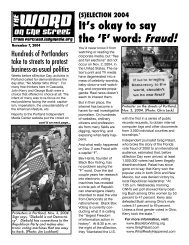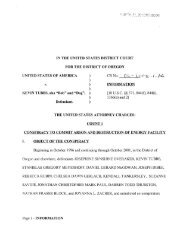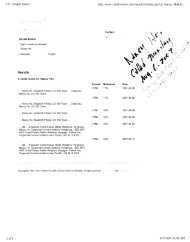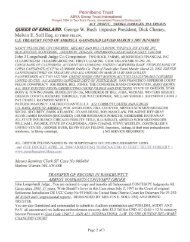Setting Fires With Electrical Timers
Setting Fires With Electrical Timers
Setting Fires With Electrical Timers
Create successful ePaper yourself
Turn your PDF publications into a flip-book with our unique Google optimized e-Paper software.
Tips for Constructing<br />
<strong>Electrical</strong> <strong>Timers</strong><br />
Special care must be given to each electrical connection.<br />
Be sure each one conducts electricity well and will not break<br />
apart during transport. Soldering wires together makes a<br />
much better connection than merely twisting them together.<br />
To join two wires: strip insulation off the end of each wire,<br />
twist them together and add a coating of solder. Wrap<br />
electrical tape around the exposed wire and continue<br />
wrapping down onto the insulated part of the wire for about<br />
an inch (see Figures A and B). Make the tape tight against<br />
the wire by pinching it and stretching it as you wrap. The<br />
electrical tape prevents short circuits and protects the wires<br />
from being pulled apart. (Helpful Tip: To get a tight fit<br />
when wrapping tape around the thin wire in these recipes, we<br />
recommend first cutting each piece of tape down the middle<br />
to reduce its width by half.)<br />
Here’s some advice on wire, batteries, battery snaps,<br />
voltmeters, epoxy and shrink tubing:<br />
• Wire: The gauge of a wire is the measure of its diameter.<br />
Contrary to common sense, a lower number means it is a<br />
thicker wire. For example, 18-gauge wire is thicker than<br />
20-gauge wire. Don’t worry about using different gauge<br />
wire on the same circuit. Thick wire is sold in many<br />
places, thinner wire is harder to find. 18 and 20 gauge<br />
wire can sometimes be found on the shelves of hardware<br />
stores and auto part stores. For thinner wire, go to Radio<br />
Shack. Beneath the colorful plastic insulation, wire is<br />
either “solid-core” (a single wire) or “stranded” (multiple<br />
smaller wires). Stranded wire is easier to work with<br />
because it is more flexible and creates better soldered<br />
connections. The solder seeps in between the strands of<br />
wire. We strongly recommend using stranded wire.<br />
• Batteries: Use batteries that say “alkaline.” Do not use<br />
the misnamed “heavy duty” or “classic” batteries. Do not<br />
use lithium cells. Do not use rechargeable nicad (nickelcadmium)<br />
batteries. Only alkaline batteries release<br />
sufficient amperage (current flow) to power a testingbulb<br />
or an igniter. Weak batteries can cause false test<br />
results. Testing with a light bulb or a Light Bulb Igniter<br />
will drain batteries quickly. During testing, keep lots of<br />
new batteries on hand and discard batteries that have less<br />
than 8.8 volts. And, of course, use only brand new<br />
batteries at the target.<br />
• 9-Volt Battery Snaps: Clocks, toys, small radios and<br />
anything else that uses a 9-volt battery will have a<br />
battery-snap (sometimes called a battery cap or a battery<br />
connector). It snaps onto the two terminals on the top of<br />
the battery. Battery-snaps can be purchased at a hobby<br />
shop or an electronic parts store such as Radio Shack. On<br />
10<br />
Figure A: Connecting Two Wires Together<br />
Step one: Strip the ends of both wires<br />
Step two: Hold the wires side by side and twist the<br />
exposed ends around each other.<br />
Step three: Add solder<br />
Step four: Cut tape in half the long way to make<br />
wrapping easier.<br />
Step five: Wrap tape to completely cover the<br />
exposed ends. Continue wrapping tape down onto the<br />
insulated wire for an inch or so.
















